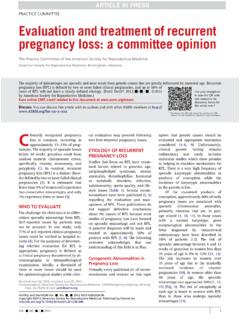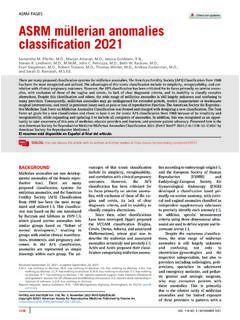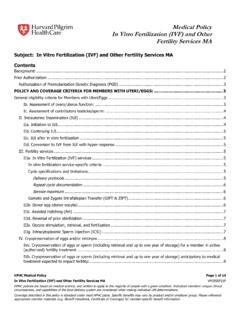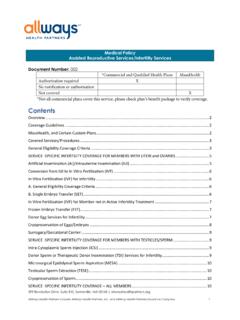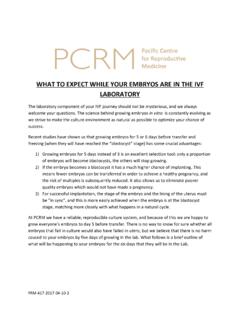Transcription of Guidance on the limits to the number of embryos to transfer
1 Guidance on the limits to the numberof embryos to transfer : acommittee opinionPractice Committee of the American Society for Reproductive Medicine and the Practice Committee for theSociety for Assisted Reproductive TechnologiesAmerican Society for Reproductive Medicine and Society for Assisted Reproductive Technologies, Birmingham, AlabamaOn the basis of American Society for Reproductive Medicine and Society for Assisted Reproductive Technology data, the American So-ciety for Reproductive Medicine's guidelines for the limits on the number of embryos to be transferred during in vitro fertilization cycleshave been further refined in continuing efforts to promote singleton gestation and reduce the number of multiple pregnancies. Thisversion replaces the document titled Criteria for number of embryos to transfer : a committee opinion that was published most recentlyin August of 2017 (Fertil Steril 2017;107:901 3).
2 (Fertil Steril 2021;116:651-54. 2021 by American Society for Reproductive Med-icine.)El resumen est disponible en Espa ol alfinal del art Words:Assisted reproduction, transfer , blastocyst, euploid, IVFD iscuss:You can discuss this article with its authors and other readers American Society for ReproductiveMedicine s (formerly The AmericanFertility Society) Guidance for the limitsto the number of embryos to be trans-ferred during in vitro fertilization(IVF) cycles aims to promote singletongestation and reduce the number ofmultiple pregnancies while maxi-mizing the cumulative live birth the incidence of high-order multiple pregnancies (three ormore fetuses in one pregnancy) havediminished in recent years, twin gesta-tions are still a relatively commonoccurrence with assisted reproductivetechnology (ART).
3 Multiple gestationleads to an increased risk of complica-tions in both the woman carrying thepregnancy and the fetuses (1 3). Eventwin gestations have significantadditional morbidity compared withthat of singletons (3). Ideally, the goalof ART is to achieve a healthysingleton gestation (4 6). Amongcycles reported to the Society forAssisted Reproductive Technology(SART) in 2017, of women<38years of age who had a successful IVFcycle had a twin gestation (7), downfrom 23% in 2014 but stillsignificantly more than half of all ART multiplegestations in the United Statesoccurred in women<35 years oldwhen 2 fresh or frozen blastocystswere transferred (8).Respect for a patient's autonomy toconsider placement of more than oneembryo requires a full discussion ofthe ethical and medical considerations,ensuring that a patient is able to make afully informed decision.
4 Elective place-ment of multiple embryos is ofteninfluenced byfinancial showed that insurancecoverage for IVF was associated withthe transfer of fewer embryos andwith significantly lower rates of high-order multiple births (9). Financial pres-sures may be a coercive tipping point infavor of multiple embryo transfer . Incontrast, if patients are informed ofthe risks inherent in twin or high-order pregnancy and thesefinancialpressures are removed or at least allevi-ated, most patients would opt to maxi-mize their chance of a singleton, safepregnancy and birth (10).Although multifetal pregnancyreduction can be performed to reducethe fetal number , the procedure mayresult in the loss of all fetuses, it doesnot completely eliminate the risks asso-ciated with multiple pregnancies, and itmay have adverse psychological conse-quences (11).
5 Moreover, multifetalpregnancy reduction is not an accept-able option for many an effort to promote singleton gesta-tions, reduce twin gestations, and elim-inate high-order multiple gestations,the American Society for ReproductiveMedicine and SART have developedthe following Guidance to assist ARTprograms and patients in determiningthe appropriate number of cleavage-stage embryos or blastocysts totransfer. National data from 2013demonstrated that clinics thatReceived June 25, 2021; accepted June 30, 2021; published online July 28, requests: American Society for Reproductive Medicine, 1209 Montgomery Highway, Birming-ham, Alabama 35216 and Sterility Vol. 116, No. 3, September 2021 0015-0282/$ 2021 American Society for Reproductive Medicine, Published by Elsevier 116 NO.
6 3 / SEPTEMBER 2021651performed higher rates of elective single- embryo transfer inwomen aged<38 years had decreased rates of multiple gesta-tions with no significant impact on clinic-level live birth rates(12). In addition, preimplantation genetic testing for aneu-ploidy maybe a tool to reduce the rate of multiple gestations,especially in women>37 years of age. In women%42 years,transferring a single euploid blastocyst resulted in pregnancyrates similar to those of transferring 2 untested blastocystswhile dramatically reducing the risk of twins (13). Strict lim-itations on the number of embryos transferred, which may berequired by law in some countries, do not allow treatmentplans to be individualized after careful consideration ofeach patient's own unique circumstances.
7 Therefore, on rareoccasions, transferring more or fewer embryos than recom-mended by this document may be justified; documentationof justification for transferring a greater number of embryosshould be recorded in the medical record, noting the individ-ual clinical conditions, including patient age, parity, medicalconditions, embryo quality, the opportunity for cryopreserva-tion, and the patient programs are encouraged to generate and usetheir own data regarding patient characteristics and the num-ber of embryos to be transferred with the goal of maintainingpregnancy rates and minimizing multiple gestations. Forexample, if a program notes a particularly high implantationrate for cleavage-stage embryos among their patients aged41 42 years, they should adjust their clinic-specific rangefor the number of embryos to transfer downward.
8 Accord-ingly, programs should monitor their results continuallyand consider decreasing the number of embryos transferredto minimize undesirable outcomes. Conversely, use of aclinic's own data cannot be used to routinely exceed the rec-ommended limits . Programs that have a multiple pregnancyrate that is well above average for all SART-reporting clinicsmay be audited by SART, and persistent noncompliance mayresult in expulsion from from young age, characteristics like the expectationof one or more high-quality embryos available for cryopreser-vation; euploid embryos ; and previous live birth after an IVFcycle have been associated with a favorable prognosis for preg-nancy. Additional favorable criteria for frozen embryo transfer (FET) cycles include the availability of vitrified, high-qualityblastocysts for transfer (14).
9 The number of embryos trans-ferred should be determined by the physician and the pa-tient(s), informed consents completed, and the informationrecorded in the clinical record. In the absence of data generatedby the individual program, and on the basis of data generatedby all clinics providing ART services, the following guidelinesare recommended for upper limits (Table 1):A. Patients with a favorable prognosis:1. transfer of a euploid embryo should be limited to one,regardless of patient Patients<35 years of age should be strongly encour-aged to receive a single- embryo transfer , regardless ofthe embryo For patients between 35 and 37 years of age, strongconsideration should be made for a For patients between 38 and 40 years of age, no morethan 3 untested cleavage-stage embryos or 2 blasto-cysts should be Patients 41 42 years of age should plan to receive nomore than 4 untested cleavage-stage embryos or Other scenarios:1.
10 In each of the preceding age groups, patients who donot meet the criteria for a favorable prognosis mayhave an additional embryo transferred according totheir individual circumstances (Table 1). The patientmust be counseled regarding the additional risk oftwin or higher-order multiple If otherwise favorable patients fail to conceive aftermultiple cycles with high-quality embryo (s) trans-ferred, the physicians and patients may consider pro-ceeding with an additional embryo to be Patients with a coexisting medical condition for whicha multiple pregnancy may increase the risk of signifi-cant morbidity should not have more than one In the rare cases in which the number of embryos orblastocysts transferred exceeds the recommendedlimits, both the counseling and the justification mustbe documented in the patient's permanent In womenR43 years of age, there are insufficient datato recommend a limit on the number of embryos totransfer when the patient uses her own oocytes.



